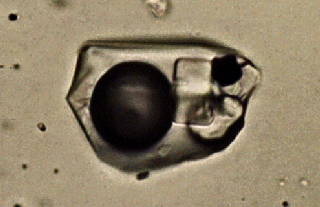
Fluid inclusions
Encyclopedia

Crystal
A crystal or crystalline solid is a solid material whose constituent atoms, molecules, or ions are arranged in an orderly repeating pattern extending in all three spatial dimensions. The scientific study of crystals and crystal formation is known as crystallography...
s. As mineral
Mineral
A mineral is a naturally occurring solid chemical substance formed through biogeochemical processes, having characteristic chemical composition, highly ordered atomic structure, and specific physical properties. By comparison, a rock is an aggregate of minerals and/or mineraloids and does not...
s often form from a liquid or aqueous medium, tiny bleb
Bleb (mineralogy)
In geology, mineralogy, and petrology, a bleb is a small bubble-like inclusion of one mineral within a larger mineral. An example is a bleb of sylvite within chlorite.- References :*Kamenetsky VS et al...
s of that liquid can become trapped within the crystal structure or in healed fractures within a crystal. These small inclusions range in size from 0.1 to 1 mm and are usually only visible in detail by microscopic study.
These inclusions occur in a wide variety of environments. For example they are found within cementing minerals of sedimentary rocks, in gangue
Gangue
In mining, gangue is the commercially worthless material that surrounds, or is closely mixed with, a wanted mineral in an ore deposit. The separation of mineral from gangue is known as mineral processing, mineral dressing or ore dressing and it is a necessary and often significant aspect of mining...
minerals such as quartz
Quartz
Quartz is the second-most-abundant mineral in the Earth's continental crust, after feldspar. It is made up of a continuous framework of SiO4 silicon–oxygen tetrahedra, with each oxygen being shared between two tetrahedra, giving an overall formula SiO2. There are many different varieties of quartz,...
or calcite
Calcite
Calcite is a carbonate mineral and the most stable polymorph of calcium carbonate . The other polymorphs are the minerals aragonite and vaterite. Aragonite will change to calcite at 380-470°C, and vaterite is even less stable.-Properties:...
in hydrothermal vein deposits, in fossil amber
Amber
Amber is fossilized tree resin , which has been appreciated for its color and natural beauty since Neolithic times. Amber is used as an ingredient in perfumes, as a healing agent in folk medicine, and as jewelry. There are five classes of amber, defined on the basis of their chemical constituents...
, and in deep ice cores from the Greenland
Greenland
Greenland is an autonomous country within the Kingdom of Denmark, located between the Arctic and Atlantic Oceans, east of the Canadian Arctic Archipelago. Though physiographically a part of the continent of North America, Greenland has been politically and culturally associated with Europe for...
and Antarctic
Antarctic
The Antarctic is the region around the Earth's South Pole, opposite the Arctic region around the North Pole. The Antarctic comprises the continent of Antarctica and the ice shelves, waters and island territories in the Southern Ocean situated south of the Antarctic Convergence...
ice caps. The inclusions can provide information about the conditions existing during the formation of the enclosing mineral.
Hydrothermal ore
Ore
An ore is a type of rock that contains minerals with important elements including metals. The ores are extracted through mining; these are then refined to extract the valuable element....
minerals typically form from high temperature aqueous solutions. The trapped fluid in an inclusion preserves a record of the composition, temperature and pressure of the mineralizing environment. An inclusion often contains two or more phases. If a vapor bubble is present in the inclusion along with a liquid phase, simple heating of the inclusion to the point of resorption of the vapor bubble gives a likely temperature of the original fluid. If minute crystals are present in the inclusion, such as halite
Halite
Halite , commonly known as rock salt, is the mineral form of sodium chloride . Halite forms isometric crystals. The mineral is typically colorless or white, but may also be light blue, dark blue, purple, pink, red, orange, yellow or gray depending on the amount and type of impurities...
, sylvite
Sylvite
Sylvite is potassium chloride in natural mineral form. It forms crystals in the isometric system very similar to normal rock salt, halite . The two are, in fact, isomorphous. Sylvite is colorless to white with shades of yellow and red due to inclusions. It has a Mohs hardness of 2.5 and a specific...
, hematite
Hematite
Hematite, also spelled as haematite, is the mineral form of iron oxide , one of several iron oxides. Hematite crystallizes in the rhombohedral system, and it has the same crystal structure as ilmenite and corundum...
, or sulfides are present, they provide direct clues as to the composition of the original fluid.
In the recent years, fluid inclusion research has been extensively applied to understand the role of fluids in the deep crust and crust-mantle interface. Fluid inclusions trapped within granulite facies rocks have provided important clues on the petrogenesis of dry granulite facies rocks through the influx of CO2-rich fluids from sub-lithospheric sources. CO2-rich fluid inclusions were also recorded from a number of ultrahigh-temperature granulite facies terranes suggesting the involvement of CO2 in extreme crustal metamorphism. Some recent studies speculate that CO2 derived by sub-solidus decarbonation reactions during extreme metamorphism has contributed to the deglaciation of the snowball Earth (Santosh and Omori, 2008).

Paleoclimate applications
Trapped bubbles of air and water within fossil amber can be analyzed to provide direct evidence of the climate conditions existing when the resin or tree sap formed. The analysis of these trapped bubbles of air provides a record of atmosphere composition going back 140 million years. The data indicate that the oxygen content of the atmosphere reached a high of nearly 35% during the CretaceousCretaceous
The Cretaceous , derived from the Latin "creta" , usually abbreviated K for its German translation Kreide , is a geologic period and system from circa to million years ago. In the geologic timescale, the Cretaceous follows the Jurassic period and is followed by the Paleogene period of the...
Period
Geologic time scale
The geologic time scale provides a system of chronologic measurement relating stratigraphy to time that is used by geologists, paleontologists and other earth scientists to describe the timing and relationships between events that have occurred during the history of the Earth...
and then plummeted to near present levels during the early Tertiary
Tertiary
The Tertiary is a deprecated term for a geologic period 65 million to 2.6 million years ago. The Tertiary covered the time span between the superseded Secondary period and the Quaternary...
http://minerals.cr.usgs.gov/gips/na/amber.html. The abrupt decline corresponds to or closely follows the Cretaceous-Tertiary extinction event
Cretaceous-Tertiary extinction event
The Cretaceous–Paleogene extinction event, formerly named and still commonly referred to as the Cretaceous-Tertiary extinction event, occurred approximately 65.5 million years ago at the end of the Maastrichtian age of the Cretaceous period. It was a large-scale mass extinction of animal and plant...
and may be the result of a major meteorite
Meteorite
A meteorite is a natural object originating in outer space that survives impact with the Earth's surface. Meteorites can be big or small. Most meteorites derive from small astronomical objects called meteoroids, but they are also sometimes produced by impacts of asteroids...
impact that created the Chicxulub Crater
Chicxulub Crater
The Chicxulub crater is an ancient impact crater buried underneath the Yucatán Peninsula in Mexico. Its center is located near the town of Chicxulub, after which the crater is named...
.
Air bubbles trapped within the deep ice caps can also be analyzed for clues to ancient climate conditions.

